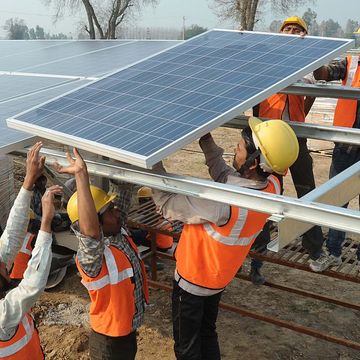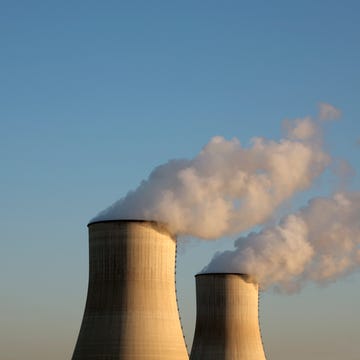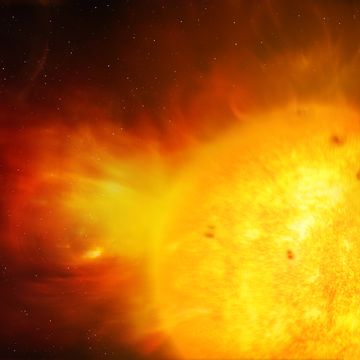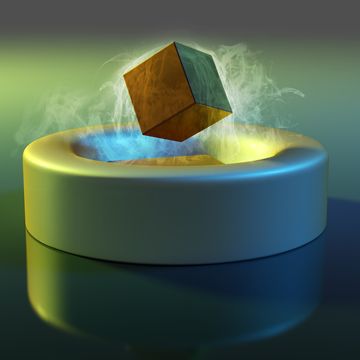The dark surface of the Pacific spreads calmly beneath the derrick of the JOIDES Resolution. On the brightly lit rig deck, the night shift is hard at work. Twelve thrusters maintain position over the Cascadia Continental Margin, 40 miles west of Vancouver Island, while the crew snakes a string of drill pipe through the ship's "moon pool" until it hits the seafloor more than a mile below. When they haul up the core barrel, it contains 31 ft. of shale, silt and clay--and traces of the world's most promising fossil fuel.
On the catwalk, a scientist in flip-down face protection quickly punctures the plastic liner that encases the sediment, in order to prevent pent-up pressure from launching it straight into the air. Another runs an infrared camera over the core's surface. On a monitor, deep purple smudges indicate areas of intense cold--and a geologic jackpot: methane gas straining against a rapidly degrading cage of icelike water.
Carved from its surroundings, a chunk of methane hydrate looks like a hard-packed snowball--white, cold and solid. At room temperature, the resemblance fades as fast as snow itself, hissing and popping as it dissolves. Light a match and the difference is even starker: It burns. Studying this unstable substance is hardly easy. Even so, the team aboard the Integrated Ocean Drilling Program's (IODP) JOIDES Resolution is part of an international community determined to understand its many paradoxes.
"Thirty years ago, hydrates were a novelty," says Miriam Kastner, a professor at Scripps Institution of Oceanography and a geochemist on the IODP expedition last fall. "We didn't realize their significance, and no one calculated how much there could be." Then someone began to do the math. Methane bound in hydrates could provide the world with an astounding amount of natural gas--if it could be safely extracted. If released inadvertently, it could cause untold damage: hastening global warming and kick-starting tsunamis by causing seafloor slumping.
In marine settings, fine-grained shale and clay result in widely disseminated hydrates. The sandy soil below Arctic permafrost, on the other hand, tends to have concentrated bands located in areas that overlap with existing oil and gas infrastructure. "Production will happen first where it is most convenient," says Scott Wilson, a petroleum engineer in Denver.
Two main extraction methods have been successfully tested at an experimental site on Canada's Mackenzie Delta. The first, called depressurization, involves drilling a hole into the hydrate layer to draw down the pressure, causing hydrates to dissociate and gas to flow up the pipe. Thermal injection, the second technique, destabilizes hydrates by pumping hot water into the deposit. Because depressurization requires less energy, Wilson calls it the "lowest-hanging fruit."
A third method appears promising, too, but has so far only been tested in a lab. Injecting carbon dioxide into a hydrate formation displaces methane, and has the added benefit of locking away an abundant greenhouse gas.
A GLOWING PROMISE
According to the U.S. Geological Survey (USGS), 100,000 to 300 million trillion cu. ft. (tcf) of methane exists globally in hydrate form--most of it in the ocean floor. "There's more energy potential locked up in methane hydrate formations across the world than in all other fossil energy resources combined," says Brad Tomer, director of the Department of Energy's Strategic Center for Natural Gas and Oil.
Up to 200,000 tcf of methane is in hydrates in the U.S. Exclusive Economic Zone. Two Rhode Island-size areas in the Blake Ridge, east of the Carolinas, contain a total of more than 2012 tcf--110 times the country's annual natural gas consumption. Substantial new deposits are still being found, including one in California's Santa Monica Basin that was announced in December.
"The quantities are there," Kastner says. "Whether or not it can be an energy source depends on how it is distributed. That's what we're trying to find out."
Hydrates form and stabilize in a very specific zone of high pressure and low temperature, where water solidifies around gas molecules to form a crystalline structure. One of the goals of the IODP expedition was to study the factors controlling where this phenomenon occurs. The type of sediment, it turns out, is crucial.
In marine settings, fine-grained shale and clay result in widely disseminated hydrates. The sandy soil below Arctic permafrost, on the other hand, tends to have concentrated bands located in areas that overlap with existing oil and gas infrastructure. "Production will happen first where it is most convenient," says Scott Wilson, a petroleum engineer in Denver.
Two main extraction methods have been successfully tested at an experimental site on Canada's Mackenzie Delta. The first, called depressurization, involves drilling a hole into the hydrate layer to draw down the pressure, causing hydrates to dissociate and gas to flow up the pipe. Thermal injection, the second technique, destabilizes hydrates by pumping hot water into the deposit. Because depressurization requires less energy, Wilson calls it the "lowest-hanging fruit."
A third method appears promising, too, but has so far only been tested in a lab. Injecting carbon dioxide into a hydrate formation displaces methane, and has the added benefit of locking away an abundant greenhouse gas.
A DARK PARADOX
But if methane gas escapes directly to the atmosphere--as a byproduct of extraction, an earthquake or warming ocean waters--the consequences could be dire. Methane is a greenhouse gas 21 times more effective at trapping heat than carbon dioxide. Today, 3000 times more methane exists in hydrate deposits than in the atmosphere. Releasing even a fraction of this amount would amplify global warming. The decomposition of hydrates near the surface of the seafloor could even trigger tsunamis by causing landslides on the continental slope.
Which helps explain why the JOIDES Resolution plied the frigid waters off the west coast of Canada last fall. "We're looking at a science that's pretty new," says Tim Collett, co-chief scientist of the expedition and a research geologist for the USGS. "Only after you understand the 'where, why and how' of hydrates can you understand the resource potential--or the hazards they represent."












